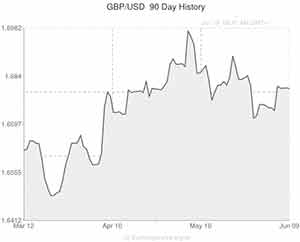
The Pound may not have put on a spectacular performance last week, but it maintained a comparatively steady relationship with the Euro (GBP/EUR) and US Dollar (GBP/USD).
Although the GBP to Euro pairing did surge following the European Central Bank’s rate decision, it slid from its 16-month high as investors considered the stimulus measures introduced by the financial institution.
The Pound also fluctuated following the release of slightly sub-par UK trade data.
However, over the weekend the British asset was supported by some provocative statements from the International Monetary Fund’s Managing Director Christine Lagarde.
According to Lagarde, the IMF’s criticisms of the UK’s austerity programme hadn’t taken into account the underlying strength of the UK’s economy.
During a televised interview for the BBC Lagarde said that the UK’s economic outlook is sustainable. She went on to assert; ‘We got it wrong. We acknowledged it. Clearly the confidence building that has resulted from the economic policies adopted by the government has surprised many of us. […] We said very clearly that we had underestimated growth for the U.K. and that our forecasts had been proven wrong by the reality of economic developments.’
The UK has shown remarkable resilience over the past 12 months, with the manufacturing, services and construction sectors all demonstrating strong growth and unemployment declining rapidly. It is expected that the nation will display the most impressive growth of any of the Group of Seven nations in 2014, with annual expansion of 2.9 per cent envisaged.
The strength of the UK economy has caused widespread speculation regarding the prospect of an interest rate increase.
While the Bank of England has repeatedly reinforced its commitment to keeping interest rates at record lows for the foreseeable future, if the UK’s economy continues outperforming estimates the central bank may have to revise its stance.
As a fresh week of trading begins Pound movement may be limited by a lack of pertinent UK data (today’s Lloyds employment confidence index is unlikely to have much of an impact).
However, there are several more influential UK reports scheduled for publication this week, including the British Retail Consortium’s like-for-like sales, manufacturing/industrial production figures, the NIESR GDP estimate for May and UK employment data.
If the employment report shows that the UK’s unemployment rate declined to 6.7 per cent in the three months to April (as forecast) the Pound could advance before the end of the week.
Economists have projected a jobs gain of 270,000 in the three month period.
Global economic developments (such as the US advance retail sales figures, German inflation data and the Reserve Bank of New Zealand’s policy decision) could also impact the Pound’s exchange rate.
Update 09/06/14 at 16:30 GMT
The Pound began Monday in a stronger position against the Euro as markets calmed following last week’s European Central Bank rate decision.
The Pound to Euro exchange rate went on to climb by 0.3 per cent as European trading continued and a measure of investor confidence for the Eurozone slid from 12.8 to 8.5 in June.
It had been expected that the measure would climb to 13.3 per cent.
Meanwhile, the Pound was bolstered by the news that British manufacturers are growing more optimistic about their future prospects. A survey compiled by EEF and BDO showed that manufacturing firms believe they will see investment and hiring increase, allowing them to post increasingly positive growth. According to the survey 34 per cent of the manufacturing firms questioned believe that they will experience improved output growth in the next quarter. This was one of the highest results recorded since mid-2007 and bodes well for tomorrow’s UK manufacturing and industrial production figures.
Sterling is also trading higher against the Euro as a result of expectations that this week’s UK employment figures will show that the nation added 270,000 positions in the three months to April, pushing the unemployment rate to 6.7 per cent.
If this estimation proves to be accurate further Pound advances may be on the horizon.
Updated 10:00 GMT 10/06/2014
The Pound to Euro exchange rate was 0.26 per cent stronger on Tuesday as investors reacted positively to upbeat UK manufacturing and industrial production reports.
As forecast by economists, manufacturing production climbed by 0.4 per cent in April, month-on-month, following a gain of 0.5 per cent in March.
Industrial production also posted the expected monthly increase of 0.4 per cent in April, wiping out the 0.1 per cent decline recorded in March.
However, both of the annual figures came as something of a surprise, with year-on-year industrial production surging by 3 per cent rather than the 2.8 per cent expected and manufacturing production leaping by 4.4 per cent on the year, up from an annual gain of 3.3 per cent in March.
The results are indicative of the UK’s resilient economic recovery and support the case for the Bank of England reconsidering its timeline for the hiking of interest rates.
Over in the Eurozone Italy’s final first quarter GDP report confirmed that the nation’s economy contracted by 0.1 per cent in the first three months of the year, quarter on quarter, and contracted by 0.5 per cent on the year.
Later today additional GBP/EUR movement could follow the release of the UK’s NIESR GDP estimate for May. Any indication that the pace of growth in the UK is slowing from the 1.0 per cent expansion posted in April could be Pound-negative.
Investors will also be looking ahead to tomorrow and the release of UK employment figures.
Pound (GBP) Exchange Rates
[table width=”100%” colwidth=”50|50|50|50|50″ colalign=”left|left|left|left|left”]
Currency, ,Currency,Rate ,
Pound Sterling, ,US Dollar,1.6786,
,US Dollar,1.6786,
Pound Sterling, ,Euro,1.2377,
,Euro,1.2377,
Pound Sterling, ,Australian Dollar,1.7945,
,Australian Dollar,1.7945,
Pound Sterling, ,New Zealand Dollar,1.9732,
,New Zealand Dollar,1.9732,
US Dollar, ,Pound Sterling,0.5952,
,Pound Sterling,0.5952,
Euro, ,Pound Sterling,0.8091,
,Pound Sterling,0.8091,
Australian Dollar, ,Pound Sterling,0.5570,
,Pound Sterling,0.5570,
New Zealand Dollar, ,Pound Sterling,0.5069,
,Pound Sterling,0.5069,
[/table]

Comments are closed.